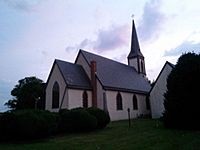St. Stephen's Episcopal Church (Earleville, Maryland) facts for kids
Quick facts for kids |
|
|
St. Stephen's Episcopal Church
|
|
 |
|
| Location | Crystal Beach Road & Glebe Road, Earleville, Maryland |
|---|---|
| Area | 3.4 acres (1.4 ha) |
| Built | 1860 |
| Architect | Dixon, Thomas |
| Architectural style | Gothic Revival |
| NRHP reference No. | 82002810 |
| Added to NRHP | April 29, 1982 |
St. Stephen's Episcopal Church is a very old and important church located in Earleville, Maryland, in Cecil County, Maryland. It's a special place with a long history.
Contents
What is St. Stephen's Church?
St. Stephen's is an Episcopal church. This means it belongs to a Christian church group that is part of the worldwide Anglican Communion. It's known for its beautiful architecture and its role in local history.
A Look at the Church Building
The church building you see today is made of brick covered in stucco. It has a single main section that is shaped like a rectangle. The building sits on a foundation made of fieldstone, which are natural stones found in fields.
The roof is very steep and covered with slate tiles. A tall, four-story bell tower stands next to the main building. This tower has a special pointed roof called a broach spire. The church's design is in the Gothic Revival style, which means it looks like older European churches from the Middle Ages.
This church was built between 1870 and 1874. However, it actually includes parts of even older churches from 1824 and 1735! So, parts of the walls are much, much older. A graveyard with old tombstones surrounds the church. A famous architect named Thomas Dixon from Baltimore designed this beautiful building.
Its Place in History
St. Stephen's Episcopal Church was originally known as North Sassafras Parish. It got this name because it was located north of the Sassafras River. This river separates Cecil County from Kent County, Maryland. This parish was one of the first 30 Anglican parishes in the Maryland area.
An Important Preacher: William Douglass
In 1834, something very important happened at this church. A man named William Douglass was ordained here. He was a Methodist preacher who became an Episcopal deacon. William Douglass was an important African American leader and an abolitionist, meaning he worked to end slavery.
After his time at St. Stephen's, he became a leader at the historic African Episcopal Church of St. Thomas in Philadelphia. He served there as a priest until he passed away in 1862. His connection to St. Stephen's shows the church's role in a significant time in American history.
The church was recognized for its historical importance in 1982. It was added to the National Register of Historic Places, which is a list of places in the United States that are worth preserving.



